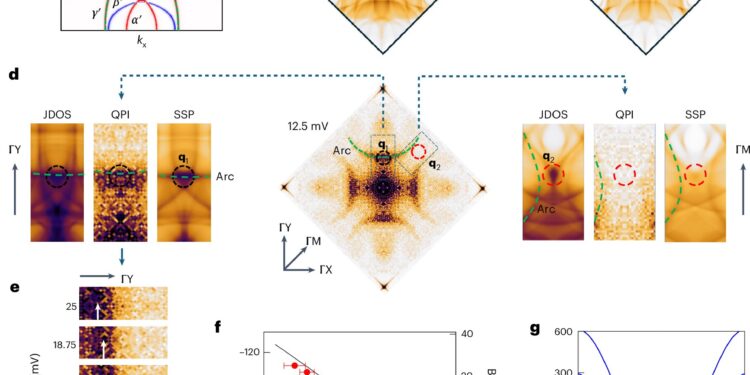Deletion of interval distribution observed in the QPI model. Credit: Nature physics (2025). DOI: 10.1038 / S41567-025-02864-2
The altermagnets, which have a spin fractionation dependent on the momentum without spin-orbit (SOC) or net magnetization, have recently attracted significant international attention.
A team led by Professor Liu Junwei of the Hong Kong University of Sciences and Technology Department (HKUST), as well as their experimental collaborators, published their latest research in Nature physicswhich revealed the first experimental observation of an alternamagnet at room temperature in two -dimensional layers, validating theoretical predictions in Nature communications Made by Professor Liu in 2021.
The realization and control of the electronic states polarized in spin in the solids are crucial for spintronic for coding and processing information. The polarization of the spin is generally generated by coupling the rotation of an electron with other degrees of freedom, such as orbital or magnetic moments.
This can involve the SOC, leading to a spin division dependent on the momentum in non -symmetrical crystals without inversion (the Rashba – Dresselhaus effect) or a break in reverse symmetry in time in ferromagnets, resulting in a spin slit independent of the momentum.
In their research studies, Professor Liu and other researchers have proposed a new spin division mechanism in antiferromagnets, where the sub-lisk linked to crystalline symmetry allow the coupling of exchange to produce a significant spin fractionation with a spin-valley locking at Pair C.
This effect is independent of SOC or Net magnetization, combining the stability of antiferromagnetic devices with a long service life. These unconventional antiferromagnets are called “alternamagnets” and their discovery has been recognized as one of the Scienceare the 10 best breakthroughs of 2024.
Despite the theoretical and experimental efforts extended to explore unconventional antiferromagnets based on emerging materials like α-MNTE, CRSB, MNTE2and ruo2None meets the requirements of symmetry and conductivity for non -relativistic preserved spin currents due to altermagnetism. The magnetic sub-lieux of α-MNTE and CRSB have a C₃ symmetry, leading to an isotropic conductance and to non-polarized currents.
Mute2The spin is not preserved due to its non -copplane magnetic structure, and its low critical temperature (87 k) limits practical applications. For Ruo2It remains controversial that its fundamental state is an antiferromagnetic or non -magnetic, despite the evidence of the abnormal effect of the room and the spin division. In addition, these materials are not in layers, restricting their potential for exfoliation and integration with other materials to control the properties at the microscopic level.
This limitation hinders the exploration of effects in 2D materials, such as topological superconductors via the superconductive proximity effect, the electronic properties adjustable by trigger and moiré super-lattices.
Consequently, the exploration of layers in altermagnets is essential for developing spintronic devices with high density, high speed and low energy consumption. The observation by Professor Liu of an altermagnet at room temperature in coats in two -dimensional layers, throws a new light on this area.
Based on the theoretical predictions of Professor Liu’s team for V2You2O and V2Se2O In 2021, this work demonstrates the realization of the locking of Spin-Vallley (SVL) in C in an Antiferromagnet (AFM) compound in RB RB layers1 -ΔV2You2O Use of resolved and angle -resolved photos spectroscopy (spin arps), microscopy / scanning tunneling (STM / STS) and calculations of the first principles.
The main results include direct observation of SVL pair in C through spin-arpe measurements, which reveal signs of opposite spin polarization between the adjacent X and Y valleys connected by crystalline symmetry C.
ARPE measurements dependent on the temperature show the stability of the SVL to room temperature, in accordance with the AFM phase transition temperature. In addition, the arpe paths confirm a strong two-dimensional character with a negligible dispersion in the KZ direction, while the almost partial interference models from STM cards reveal the inter-valley dissemination deleted due to the rules of selection of the spin.
The work of Professor Liu demonstrates the first AFM metal at room temperature in layers with alternating magnetic sub-lieu and a new type of spin-spin effect, offering an ideal platform for other studies and applications in the spintronic and the valley.
Above all, all the experimental results align well with the calculations of the first principles, strengthening confidence in theoretical work and suggesting potential access to the currents preserved in spin and unconventional piezomagnetism.
Similar spin-valley locking has also been observed in the V interchated in K2Se2O, more validating the theoretical predictions of Professor Liu in 2021.
More information:
Fayuan Zhang et al, spin – Valley with a crystal peer -symmetry locking in a metal altermagnet candidate at room temperature in layers, Nature physics (2025). DOI: 10.1038 / S41567-025-02864-2
Supplied by the University of Sciences and Technologies of Hong Kong
Quote: New era of magnetization: Research highlights the future applications of Spintronics and Valleytronics (2025, May 3) recovered on May 4, 2025 from
This document is subject to copyright. In addition to any fair program for private or research purposes, no part can be reproduced without written authorization. The content is provided only for information purposes.



